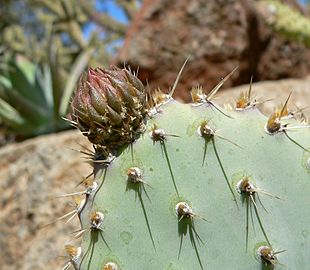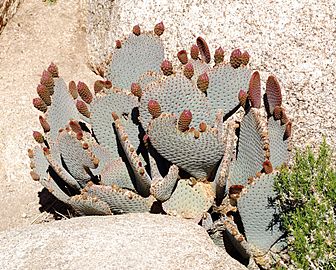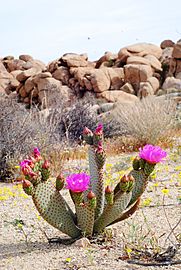Beavertail cactus facts for kids
Quick facts for kids Beavertail cactus |
|
|---|---|
 |
|
| Conservation status | |
| Scientific classification | |
| Genus: |
Opuntia
|
| Species: |
basilaris
|
The beavertail cactus or beavertail pricklypear (scientific name: Opuntia basilaris) is a type of cactus. You can find it in the southwestern United States and parts of northwest Mexico. It grows mostly in the Mojave, Anza-Borrego, and Colorado Deserts. It also lives in the Colorado Plateau, the Grand Canyon, and along the Colorado River. You can even spot it in southern Utah, Nevada, and western Arizona.
What Does It Look Like?
The beavertail cactus is a small to medium-sized prickly pear cactus. It usually grows about 70–400 mm (2.8–15.7 in) tall. Its flowers are a beautiful pink to rose color.
A single plant can have hundreds of flat, fleshy pads. These pads are often blue-gray, but their exact color can change depending on the type. They are about 50–210 mm (2.0–8.3 in) long, less than 100 mm (3.9 in) wide, and 10–15 mm (0.4–0.6 in) thick.
Most beavertail cacti do not have large spines. However, like other Opuntia species, they have many tiny, barbed bristles called glochids. These glochids can easily stick into your skin, so it's best not to touch them! The beavertail cactus blooms from spring to early summer.
-
New buds growing in Joshua Tree National Park.
-
Beautiful flowers in Joshua Tree National Park.
Different Kinds of Beavertail Cactus
There are several different types, or varieties, of the beavertail cactus. Scientists generally accept four main ones:
- Opuntia basilaris var. basilaris
- Opuntia basilaris var. brachyclada – also known as the Little beavertail pricklypear
- Opuntia basilaris var. heilii – Heil's beavertail
- Opuntia basilaris var. longiareolata – also called the Elongated beavertail prickly pear or Grand Canyon beavertail pricklypear
- Opuntia basilaris var. treleasei – Trelease's beavertail prickly pear, or Bakersfield cactus. This type is very special because it is considered endangered. This means it is protected by law in California, and it's against the rules to harm or take it.
The Trelease's beavertail is unique among the varieties. It sometimes has small spines along with its bristles, showing how much this cactus can change its look.
How People Used It
The Cahuilla Native Americans, who lived in the desert regions, used the beavertail cactus as an important food source. They would cook or steam the buds before eating them or storing them for later. The large seeds were also ground up and eaten as a mush.
See also
 In Spanish: Cacto de Beavertail para niños
In Spanish: Cacto de Beavertail para niños






